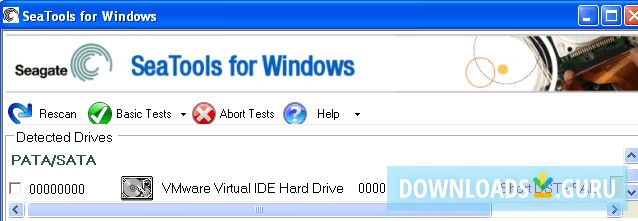
These tests are disk-intensive and will draw more current than a typical usage profile.
Plug in your laptop computer - Laptop systems should not run the long tests using just battery power. The setting " Turn off hard disks" should be set to " Never" while running any SeaTools for Windows test. Click on the Start or Windows icon button in the bottom left corner of your Windows desktop. The drive is working on its own at these times and the system may decide it should go into Standby or Hibernate modes. A complete drive scan may take a few hours to complete. Keep the computer fully powered on - Power management controls may need to be suspended while doing very long tests. Most desktop and notebook systems have one SATA or PATA internal drive. Internal drives are identified as PATA (Parallel ATA or IDE), SATA (Serial ATA), SCSI, or SAS (Serial-Attached SCSI).  SeaTools' Drive Identification - External drives that connect to the system through USB, 1394 Firewire, or eSATA do not have the same background activity as the internal drive. This is harmless to the drive and a routine condition of use however, it causes the SeaTools tests to take much longer time to complete. This is harmless to the drive and a routine condition of use however, it causes the SeaTools tests to take much longer time to complete. When that happens, SeaTools will temporarily suspend its current progress while the drive is busy.
SeaTools' Drive Identification - External drives that connect to the system through USB, 1394 Firewire, or eSATA do not have the same background activity as the internal drive. This is harmless to the drive and a routine condition of use however, it causes the SeaTools tests to take much longer time to complete. This is harmless to the drive and a routine condition of use however, it causes the SeaTools tests to take much longer time to complete. When that happens, SeaTools will temporarily suspend its current progress while the drive is busy. 
Otherwise, Windows will continue to give the disk drive commands to access data for the needs of the other applications. The main reason for this is to keep the drive focused on SeaTools as much as possible.
 Isolate SeaTools - close all other applications before running a hard disk diagnostic. If you have a SeaTools for Windows icon on your desktop, simply launch the program from here. Launch SeaTools by following these steps once it is installed:
Isolate SeaTools - close all other applications before running a hard disk diagnostic. If you have a SeaTools for Windows icon on your desktop, simply launch the program from here. Launch SeaTools by following these steps once it is installed:







 0 kommentar(er)
0 kommentar(er)
